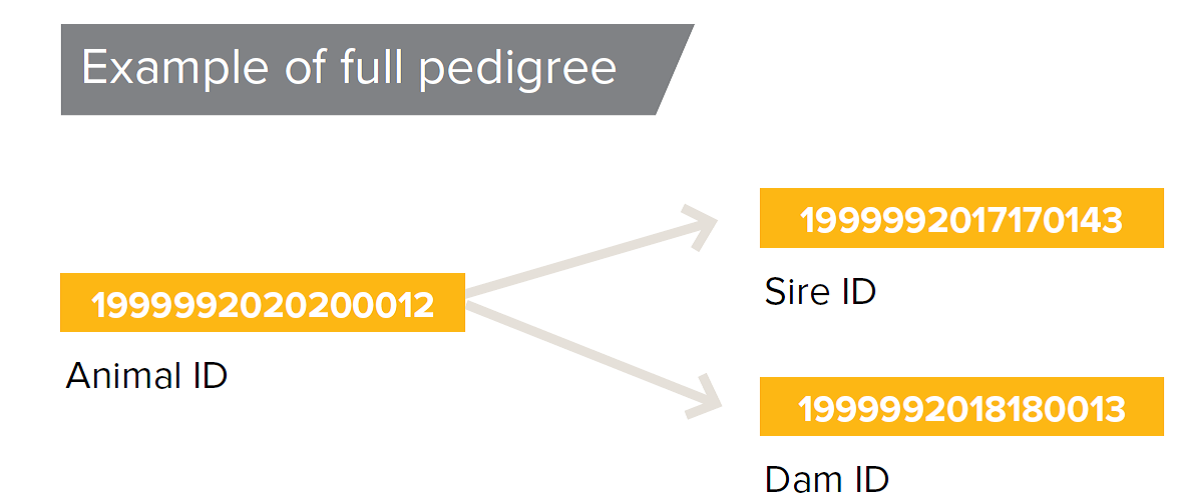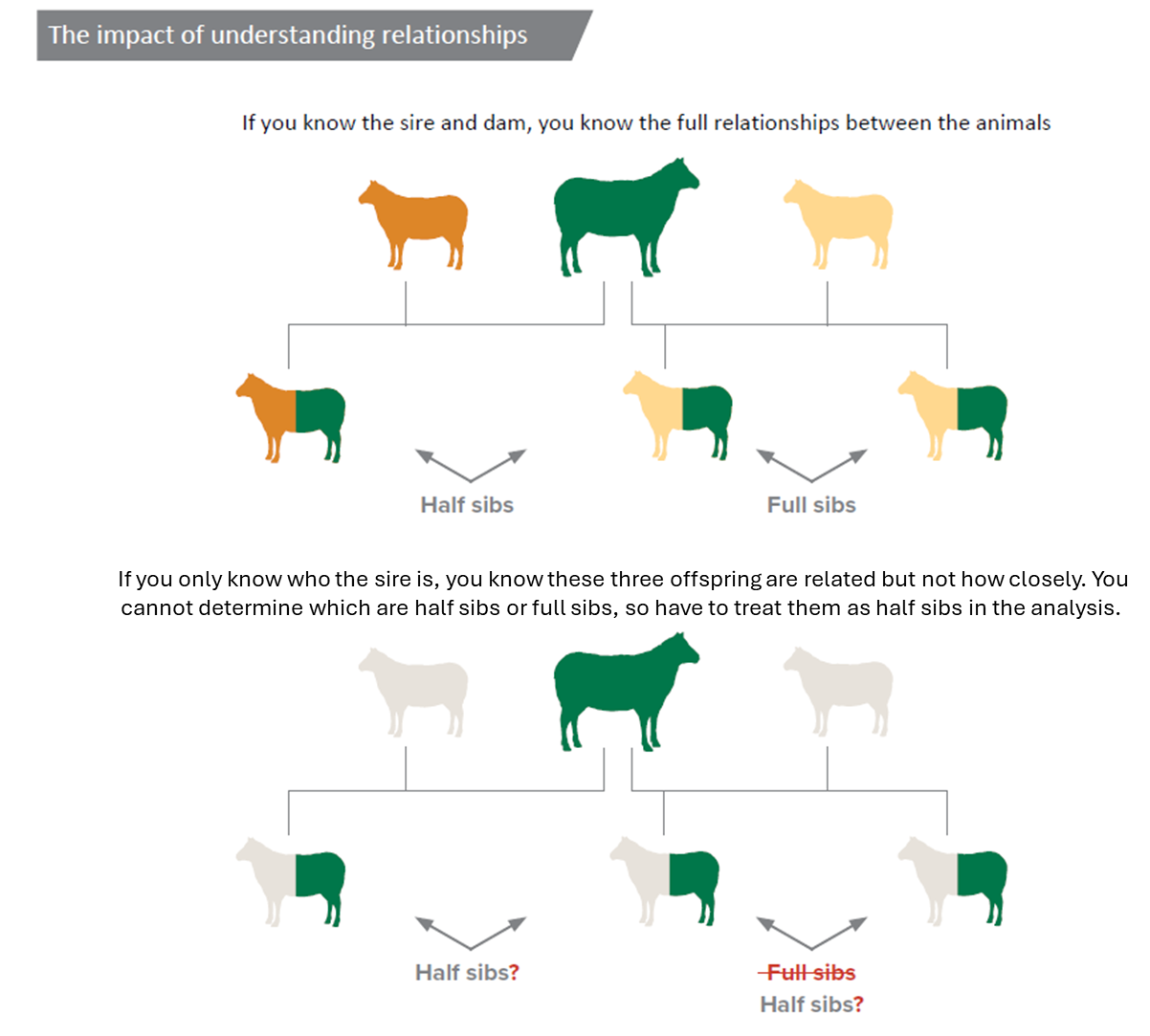Pedigree
Once you create a unique 16-digit ID for each animal, you can describe relationships between animals. Accurate pedigree is important because Sheep Genetics uses relationships between animals to estimate breeding values.
Pedigree is determined by entering the ID of the animal and their parents (sire and dam). Where sire or dam is not known, these fields are left blank. Full pedigree is where we have a known sire and dam for an animal.

Sire pedigree
Sire pedigree is obtained by recording:
- Which individual rams were mated to which group of ewes (single-sire mating)
- Which ewes were artificially inseminated using semen from a ram
- Use of DNA parentage if syndicate mating
Syndicate pedigree
Syndicate pedigree refers to when you use a team of rams for joining and do not know which individual ram sired which progeny.
Providing individual sire pedigree estimates the breeding values more accurately than when you submit syndicate pedigree.
To submit syndicate pedigree, you need to create a new ID for the syndicate. Sheep Genetics refers to these as named syndicates. For example:
199999 2019 NAM001
Use your breed and flock code when naming the syndicate.
The year of birth in the ID will be one year less than the progeny from the syndicate (eg for a 2020 drop lamb, its syndicate will contain 2019 in its ID).
NAM refers to a named syndicate.
Important
|
How does Sheep Genetics use syndicate information?
Because which sire was mated to which dam is unknown, the breeding values of the syndicate ram team are averaged to produce the sire breeding value that contributes to the progeny. Therefore, if a syndicate must be used it is best if to use rams with similar breeding values for the traits you are interested in. By using rams with similar breeding values, the average breeding value is closer to all the sires’ actual breeding values. One strategy is to use related rams in the syndicate, such as half-siblings.
The performance of progeny does not contribute information back to the sire’s breeding value.
Syndicates also do not provide any linkage to the progeny.
The impact of syndicate mating on these calculations would be rectified by getting individual sire pedigree.
Why individual sire pedigree is preferable to syndicate pedigree?
Syndicate matings are challenging because you cannot control which rams join which ewes. Additionally, twin lambs with the same dam can have different sires.
In the evaluation:
- Syndicate pedigree does not provide linkage
- The performance of syndicate progeny does not contribute back to the ram’s ASBVs (as the evaluation cannot attribute the performance to an individual sire).
Sheep Genetics strongly encourages establishing individual sire pedigree rather than using named syndicates.
If you are using DNA at a later date to determine single sire pedogree, update to the correct pedigree sire in your software and resubmit the file to Sheep Genetics. Do not update the ram joined ID in the mating module, keep that as the syndicate for the mating analysis.
Dam pedigree
Collecting dam pedigree involves recording the 16-digit ID of the mother of an animal.
Why is dam pedigree important?
Dam pedigree is important as it allows Sheep Genetics to more completely estimate relationships between animals.
When you submit dam pedigree:
- breeding values are more accurate
- maternal effects can be estimated
- reproductive traits can be recorded
- full sibling relationships can be identified
- linkage between years is better
- you can collect more information about how the animals are born and raised (particularly if tagging at birth)
- having full pedigree allows the calculation of inbreeding.

What happens if I do not know the sire or dam?
When you have missing pedigree, Sheep Genetics fills the gap with your genetic group. You can think of the genetic group as one parent which adopts all the lambs for which you do not have a sire or a dam. This genetic group gets a breeding value like all the other animals you submit.
This means if you do not submit a sire or dam for an animal, the breeding value of that animal is estimated assuming all the missing parents in the pedigree are the same. The breeding values of all the animals with missing pedigrees (the genetic group) are estimated based on the same breeding values. This reduces the accuracy of the estimation and may mean some animals have breeding values lower than what they really are, or do not meet the accuracy and linkage thresholds required to be reported. It is important to submit pedigrees for all animals you can.
|
Important
|
Discussing pedigree recording methods
Technique |
Advantages |
Disadvantages |
Tag at birthLambing round at least once a day, recording any lambs that have been born in the last 24 hours |
Best data quality You can record:
|
High labour cost/input Disturbing the mother and lamb could cause mismothering Requires single sire mating or AI (or DNA parentage) to inform sire pedigree |
Lambing rounds from a distanceDuring lambing, you check lambing ewes at least once a day to record who gave birth from a distance.
|
Collects accurate birth date and birth type Minimal disruption to birth site Low labour inputs |
Does not capture additional brith traits such as birth weight or maternal behaviour You need to mother up later using another technique to actually match ewes to lambs Requires single sire mating or AI to inform sire pedigree |
DNA parentageLambs and all potential parents are sampled using tissue sample units (TSUs) and DNA is processed, and parentage then allocated.
|
You can identify individuals from a syndicate mating Convenient Less labour intensive Assigns both sire and dam (if both potential parents are also tested) |
Limited control over allocation of rams to ewes if syndicate mating Extra expense First year particularly expensive as you need to DNA test all possible sires and dams No information on birth (including birth date) Takes time to get results processed and returned |
Proximity collarsYou attach a collar with proximity sensor pods to both the ewes and lambs. It allocates the ewe to the lamb based on how much time they spend near each other. |
Generally a less expensive method Quick and easy |
No information collected at birth Single sire mating or AI required to inform sire pedigree Labour intensive (in short bursts) when attaching and removing collars Risk that the maternal mother is identified rather than the genetic mothering (where pirating has occurred) |
Pedigree MatchMakerAn electronic tagging system which identifies which lamb belongs to which ewe based on how often they walk through a draft together. |
Relatively cheap Don’t have to be at the birth site |
Not always a viable option for some flocks, as environment may not be suitable (e.g. too many watering points) Single sire mating or AI required to inform sire pedigree Requires training of animals to walk through the device
|
Mothering up away from birth siteYou match the mother and her lamb/s in the yards by observing how lambs and ewes interact. |
Relatively cheap |
Variable accuracy depending on the age of the lambs Mismothering Labour intensive for short periods Single sire mating or AI required to inform sire pedigree
|
Nominating Pedigree Type
Pedigree type provides the method through which pedigree was derived for the animal. It is an important piece of information to include in your data as it is used in the check and confirm the pedigree you supply.
Pedigree type is allocated for both the sire pedigree and the dam pedigree, and can include:
- Mothering at birth, or later at marking or weaning,
- DNA parentage
- Pedigree Matchmaker,
- Single Sire lambing,
- Inferred from Dam,
- Inferred from lambing date,
- Other
This field is particularly important where DNA parentage is used, as in many cases ewes are joined to syndicate ram teams, and individual sire pedigree is gained from DNA. Where this occurs, there can be multiple lambs with the same dam, however different sires. This pedigree data is excluded from the evaluation due to “twins by different sires” unless the pedigree type for the sire is nominated as DNA.
Conception method
Conception method indicates how a lamb was conceived, and is an important validation of pedigree supplied, reproduction and can impact the grouping of animals.
Conception methods can include:
- Natural (1)
- Embryo Transfer (2)
- Artificial Insemination (3)
- Juvenile In Vitro Embryo Transfer (4)
- Multiple Ovulation Embryo Transfer (5)
- Pen or yard mated (6)
Where there is no conception method supplied, animals are assumed to have been conceived naturally. This can cause issues particularly if you are running an ET program, with common exclusions appearing:
- Too many lambs from the same dam for natural (or AI) conception
- Lambs from of the same dam are born on different days
Where these exclusions occur, the dam pedigree of the lambs is excluded from the evaluation.
What should I do if using embryo transfer (ET)?
- Enter the donor of the embryo as the dam pedigree of the lamb.
- Record the conception method of the ewe and lamb in your software (ET is 2)
- It is recommended that you use a ewe that exists in Sheep Genetics as the recipient, as we can better account for the maternal environment. Record a Sheep Genetics ID for the recipient dam.
- Have at least two sires represented among each ET drop. ET lambs are grouped separately to natural/AI born lambs.
- Use at least one of the sires used in your ET program in an AI or natural mating program to ensure good genetic linkage between ET and non-ET progeny.
- Record any naturally conceived progeny from donor dams to enable evaluation of their maternal traits.
Important
|